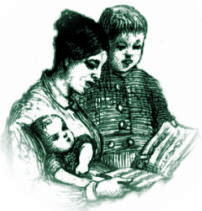|
|
Granted, TeleRead by itself is not the solution to the literacy crisis and will not overnight turn America into a country of book lovers. We also need inspired, supportive teachers who care about books and are willing to ask students the right questions about their reading. At St. Elizabeth's Parochial School on the South Side of Chicago, teacher Pierrette Devers is using Rocket eBooks to increase the variety of books and other texts with which she can stretch young minds through classroom discussion. TeleRead could never replace Mrs. Devers. But it could make it easier for people like her to do their jobs. Now, imagine going a step beyond St. Elizabeth's; suppose TeleRead could indeed "bring the books home." Then even more benefits will follow--by encouraging more interest in books among parents, who to a great extent are children's role models. Even better, by making it easier for students with similar interests to share books simultaneously, rather than waiting for them to be available at the library, TeleRead could use peer pressure. Children could even beam books to each other via infrared or radio waves, or perhaps share through the Internet. Of course this scenario of sharing might not happen without tracking mechanisms--to ascertain the popularity of books for the purpose of providing for the right level of compensation for copyright holders from a national digital library fund. TeleRead calls for such mechanisms. For a discussion of the clashes between legalities and good education--so reliant on sharing--see David Rothman's 1995 paper for the U.S. Department of Education. The importance of the question in the title hasn't diminished: Copyright and K-12: Who Pays in the Networked Era? Meanwhile, lest mothers and fathers simply wait for nirvana, they would do well to find out what is already on the Net--and see how other parents are using the free resources there. |



 observed. That is life today. But what if a huge number of virtual library books could enter the home electronically, so that tired parents did not have to take children so often to physical bookstores or libraries? And what if these e-books were free or at least much less expensive than the paper variety? That is the thinking behind TeleRead. Novels and textbooks are just two examples. Look closely at the picture from the
observed. That is life today. But what if a huge number of virtual library books could enter the home electronically, so that tired parents did not have to take children so often to physical bookstores or libraries? And what if these e-books were free or at least much less expensive than the paper variety? That is the thinking behind TeleRead. Novels and textbooks are just two examples. Look closely at the picture from the